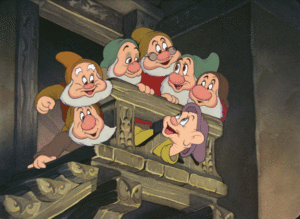
A name and story we all know and love (maybe more so than others), Snow White and the Seven Dwarfs made its debut in 1937 and stands as the first princess story to kick off Walt Disney’s golden age of animation. Though it does not hold title as the first feature length animated film, it was a huge leap in the quality, technology, and story capabilities of animation till this day.
However, there was many skepticism surrounding the film even before its premiere. Snow White was so far ahead of the cartoons at the time that over its three year production period, many of the film critics then questioned if it was even possible to be made. In addition, there was a rising concern revolving around the audience’s interest. It was very rare to have an audience stay captivated in a cartoon story for more than an hour but this is where Walt changed the course and perspective of animated films. In order to keep the audience engaged, Walt knew they would need to have an emotional connection to the film the earlier cartoons were unable to produce. In order to do this, Walt needed to embrace Snow White with a sense of realism. Giving the audience the feeling that this was all happening to a real person who would think and feel, allowing them to empathize with Snow White and the seven Dwarfs all while retaining the charm and fairytale elements that comes from the unreal nature of animation. Almost all of the decisions in production was pointed to embody this balance, from the writing, character movements and designs, music, and effects.

After all of Walt and his team’s tireless efforts in producing the film, the story was released, following princess Snow White, who embodies all beauty, innocence, and above all, love. White charms every creature in the kingdom, including a prince, except one – her envious, vein stepmother, the Queen. Jealous of White’s innocence and youth along with the Magic Mirror’s proclamation of her as the “fairest of them all,” the Queen sends a huntsman to kill White. Unable to complete the task against the beautiful princess, the Huntsman implores White to flee in the forest only to return the heart of a pig to the Queen. In the midst of her run, Snow White finds herself in a cottage and befriends seven lovable dwarfs – Doc, Sneezy, Grumpy, Happy, Bashful, Sleepy, and Dopey. But when the Queen discovers the truth, she thus undergoes in disguise to trick innocent Snow White with an enchanted apple which puts her into a deep sleep, only with the magic of true love’s kiss to save her – from a prince possibly?
Snow White and the Seven Dwarfs was the first film to utilize the multi-plane camera, which allowed the background to give the impression of movement beyond simply side-scrolling, as was the standard at the time. It also made possible new types of special effects, such as the movements of water, and the flickering of the stars or light. The greatest example of this occurs after Snow White and the animals have finished cleaning the dwarfs’ cottage. How the camera pulls back to reveal a forest that hadn’t previously been in the frame. This is a simulated camera move, using the multi-plane camera. One can almost imagine the multi-plane camera pulling back (i.e. up) to achieve this shot.
But Team Disney didn’t stop there. They decided to fill the film with a number of sophisticated “directing” techniques. One of greatest directing techniques in Snow White comes during the wishing well scene and the introduction of Prince Charming. We start with a high angle shot looking down into the bottom of the well, seeing Snow White’s reflection in the well water. Suddenly, Prince Charming appears behind her — in a reflection — to finish the verse of her song, “I’m Wishing” with a rousing, “Today!!” The pacing and coordination of the whole sequence conveys the essence of fate in a fairytale narrative while keeping the realistic visuals of a live action.
Another great example includes the Queen’s transformation. How the room spins around the Queen as she takes the magic potion and transforms into the witch. With the use of the multi-plane camera, we get a three-dimensional visual which creates its own form of horrifying, disorienting vertigo.
In conjunction of the realism bestowed on the characters and designs with the advanced technology of the multi-plane camera, Snow White and the Seven Dwarfs revolutionized storytelling within not only the animation realm, but in all of cinema. Of all the innovations that Disney has brought to animation, this is the one that changed everything. The emotional response to the film, then and now, is the reason why an audience can sit for over an hour and become completely absorbed in a magical world. Because no matter how fantastic and extravagant the art is, the story is grounded to the same reality that effects you and me.
Sources:
